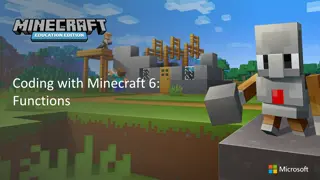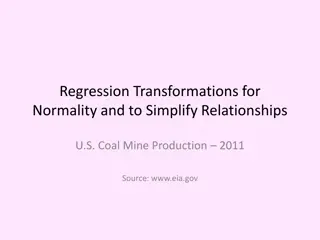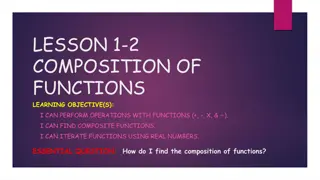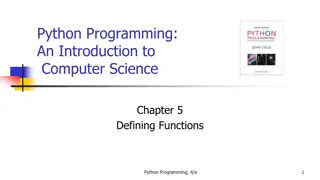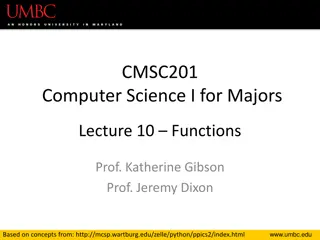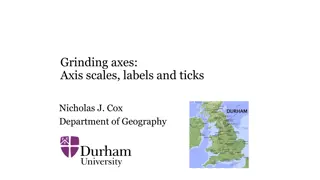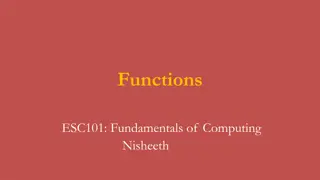Lenticulars adhesive label, Lenticular security labels, Custom lenticular stickers Manufacturer from Kolkata India
Understanding the diverse needs of the clients,we have come up with an excellent range of Lenticular Label. Our offered range is a piece of ribbed plastic, ranging from 15 line per inch to 150 line per inch. Each rib is a lens and each lens is set up according to viewing distance, depth and field to
0 views • 3 slides
Logarithmic Function Transformations
Explore transformations of logarithmic functions through examples involving vertical and horizontal stretches, translations, and reflections. Understand how to sketch the graphs of logarithmic functions and determine missing coordinates on the graphs. Additionally, learn about transformations such a
3 views • 9 slides
Livestock Marketing Functions and Classification
Livestock marketing involves various functions such as exchange, physical supply, facilitative functions like grading, transportation, storage, and more. These functions are classified into primary, secondary, and tertiary functions based on their roles. Assembling, processing, distribution, and equ
3 views • 23 slides
Logarithmic Functions with Examples
Explore logarithmic functions based on the book "Functions, Data, and Models" by S.P. Gordon and F.S. Gordon. Learn about population growth modeling, logarithm definitions, fundamental identities, and solving equations using logarithms. Examples include determining population growth, solving for var
1 views • 17 slides
Review of Definite Integrals using the Residue Theorem
Singular integrals involving logarithmic and non-integrable singularities are discussed, emphasizing integrability in the principal value sense. Cauchy Principal Value integrals and examples of their evaluations for singularities like 1/x are explored, highlighting the necessity of passing through t
1 views • 48 slides
Domain and Range of Functions
Understanding functions involves exploring concepts such as domain, range, and algebraic inputs. This content covers topics like constructing functions, common functions like quadratic and trigonometric, and solving functions based on given domain and range. It also provides practice questions to te
1 views • 21 slides
Hyperbolic Functions and Their Inverses
This content delves into the world of hyperbolic functions, discussing their formation from exponential functions, identities, derivatives, and inverse hyperbolic functions. The text explores crucial concepts such as hyperbolic trigonometric identities, derivatives of hyperbolic functions, and integ
1 views • 9 slides
Laws of Logarithms: Exponents vs. Logarithms
Laws of Logarithms explain the properties and rules governing logarithmic functions, involving evaluations, conversions, additions, subtractions, and comparisons with exponent laws. Through examples, the laws of logarithms are applied to simplify expressions and evaluate logarithmic equations. The r
0 views • 17 slides
Parent Functions and Their Characteristics
This informative content explores different parent functions such as linear, quadratic, cubic, square root, reciprocal, exponential, and logarithmic functions. It delves into their unique properties, graphs, and functions, offering insights into domain, range, and key characteristics of each functio
1 views • 11 slides
Functions in Python: Basics and Usage
In this lecture on functions in Python, the focus is on the basics of defining and using functions. The session covers the formal definition of functions, parameters, local and global scopes of variables, return values, and pass-by-value concept. It emphasizes the importance of proper indentation in
4 views • 28 slides
Logarithmic Functions and Their Inverses
Mathematically exploring logarithmic functions, their properties, inverse functions, exponential forms, and rewriting logarithmic expressions. Learn how to evaluate logarithms through examples and understand the relationship between exponential and logarithmic forms.
0 views • 24 slides
Functions: Tables, Graphs, and Formulas Based on Functions, Data, and Models
Explore the world of functions through tables, graphs, and formulas in this presentation based on the book "Functions, Data, and Models" by S.P. Gordon and F.S. Gordon. Learn how functions in the real world work, understand the relationship between variables, and see different representations of fun
0 views • 29 slides
SQL Functions for Database Queries
SQL functions are essential elements in performing actions and obtaining results in a database query. They come in two main types: scalar functions and aggregate functions. Scalar functions operate on single values, while aggregate functions operate on sets of data. Examples of SQL functions include
1 views • 14 slides
Logarithms and Logarithmic Laws
Logarithms help us determine the power to which a base must be raised to give a specific result. This content explains concepts like logarithmic laws, changing bases, solving logarithmic equations, and includes examples for better understanding.
0 views • 8 slides
Basis Functions and Hemodynamic Response Functions in fMRI Analysis
This content discusses the use of basis functions, parametric modulation, and correlated regressors in the first-level analysis of fMRI data processing. It delves into the concept of temporal basis functions for modeling complex functions of interest, such as the canonical hemodynamic response funct
1 views • 26 slides
Convex Optimization: Interior Point Methods Formulation
This chapter on interior point methods in convex optimization explores the formulation of inequality-constrained optimization problems using barrier methods and generalized inequalities. It covers primal-dual interior point methods and discusses issues such as exponential complexity and determining
0 views • 24 slides
Functions in Coding with Minecraft
Functions in coding are self-contained sets of instructions that perform specific tasks within a computer program. They allow for code reuse and save time by writing instructions once as a function and calling it whenever needed. This content covers the purpose of functions, how they save time when
1 views • 30 slides
Mathematics and Economics in Social Sciences
Explore the intersection of mathematics and economics in social and behavioral sciences through examples in algebra, precalculus, and real analysis. Solve problems related to demand functions, supply curves, subsidies, and taxes. Understand the impact of programs like WIC on family budgets. Discover
0 views • 20 slides
Regression Transformations for Normality and Simplification of Relationships in U.S. Coal Mine Production 2011
The study analyzes Coal Mine Production data from 2011, focusing on predictor variables like Labor Effort, Surface Mine status, and regional factors. An initial regression model with interactions is presented, but residual plots indicate the need for transformation. The Box-Cox transformation is emp
0 views • 13 slides
Earthquake Magnitudes and Seismic Measurements
Delve into the fundamentals of engineering seismology and earthquake magnitudes, exploring topics such as fault dimensions, slip distribution, spectral shapes, Richter's observations, and logarithmic scales. Gain insights into how seismic measurements are characterized and understand the significanc
0 views • 69 slides
Wind Profiles and Aerodynamic Roughness Length
Wind profiles are crucial in understanding how wind speed changes with height in the boundary layer. The logarithmic and power law profiles depict this relationship, influenced by surface characteristics and obstacles. The aerodynamic roughness length, defining where wind speed becomes zero, remains
0 views • 14 slides
Composition of Functions in Mathematics
Learn how to perform operations with functions, find composite functions, and iterate functions using real numbers. Explore the composition of functions through examples and understand the domain of composite functions. Enhance your mathematical skills by mastering operations like addition, subtract
0 views • 10 slides
Functions in C Programming
Functions play a vital role in C programming by enabling the execution of specific tasks. They can be pre-defined or user-defined, offering flexibility and efficiency in code organization and execution. Pre-defined functions are already available in C libraries, while user-defined functions are cust
2 views • 46 slides
Composite and Inverse Functions
Learn about composite functions, inverse functions, and how to find their compositions and inverses through examples and step-by-step explanations. Explore the concept of forming composite functions, verifying inverse functions, and finding the inverse of a function using interchange and solving met
0 views • 15 slides
Introduction to Defining Functions in Python Programming
This chapter introduces the concept of defining functions in Python programming. It covers the importance of dividing programs into sets of cooperating functions, defining new functions in Python, understanding function calls and parameter passing, and reducing code duplication through the use of fu
0 views • 78 slides
Functions in Computer Science I for Majors Lecture 10
Expanding on the importance of functions in programming, this lecture delves into dividing code into smaller, specific pieces, defining functions in Python, understanding function calls and parameter passing, and using functions to enhance code modularity. Key topics covered include control structur
0 views • 62 slides
Finite-time Analysis of the Multiarmed Bandit Problem in Advanced Algorithms Seminar
This study delves into the Stochastic Multiarmed Bandit Problem and explores achieving logarithmic regret uniformly over time. It covers problem settings, notations, previous work, objectives, results, and proofs, including the usage of the UCB1 policy. The theorem and its proof demonstrate the expe
0 views • 43 slides
Mastering Graph Axes Customization: Techniques and Tricks
Explore advanced techniques for customizing graph axes by adjusting scales, labels, and ticks. Learn how to suppress ticks, modify label alignment, and work with non-standard scales like logarithmic or reciprocal. Discover ways to maintain consistent styles across a series of graphs and gain more co
0 views • 57 slides
Revisiting Adjustor Curves for Total Phosphorus Removal Rates
Based on a literature review, it was found that a 5th-order polynomial curve is a better fit than the originally used logarithmic trendline for anchor rates of percent Total Phosphorus removal related to runoff depth. The expert panel report reflects the old curves while trendline equations in FAQ d
0 views • 7 slides
Housing Demand Theory in Urban Economics
Explore the nuances of housing demand theory in urban economics, covering topics such as alternative utility functions, exponential density functions, maximizing bid functions, and comparative statics. Delve into Stone-Geary and CES utility functions, their implications on demand functions, and the
0 views • 35 slides
Functions and Graphing in Mathematics
Functions and graphing play a crucial role in quantitative and qualitative reasoning. We explore the concept of points on a graph, coordinates, relations, functions, and ways to express functions. Utilizing visual aids and analogies, we delve into the importance of coordinates, the distinction betwe
0 views • 10 slides
Closures, Lambda Functions, and Higher-Order Functions in Programming
In programming, closures bind functions and lexical environments, while lambda functions are nameless and used by higher-order functions. Higher-order functions operate by applying other functions, such as map and fold functions. Example implementations in LISP demonstrate how these concepts are uti
2 views • 16 slides
Introduction to Python Functions: Overview and Usage
In this module, we delve into Python functions, exploring common built-in functions and how to create custom functions. We learn the properties of functions, how to coordinate multiple functions, and concepts of modularization. Discover the essence of functions in Python programming through practica
0 views • 17 slides
Methods of Integration and Trigonometric Substitution
Explore methods of integration including integration by parts and trigonometric substitution. Learn how to apply these techniques to solve integrals involving logarithmic, trigonometric, and rational functions. Discover step-by-step processes and identities to simplify and evaluate various types of
0 views • 7 slides
Derivative of Logarithmic Functions
Learn how to find derivatives of logarithmic functions using natural logarithms, important techniques for challenging derivatives involving functions raised to functions, sine, product, quotient, and chain rule problems. Follow steps in logarithmic differentiation to simplify calculations and solve
0 views • 5 slides
Functions in C Programming
Functions play a crucial role in C programming, allowing for modularity and reusability of code. This content covers the basics of functions, creating custom functions, passing arguments, returning values, and the anatomy of a C function. Learn about defining functions, passing arguments effectively
0 views • 24 slides
AVL Trees: Balanced Search Trees for Efficient Operations
AVL Trees are balanced search trees that ensure efficient insertion, deletion, and retrieval operations with a worst-case time complexity of O(log N). Named after their inventors Adelson-Velskii and Landis, AVL Trees maintain balance by limiting the height difference between left and right subtrees
0 views • 28 slides
Logarithms: Laws, Examples, and Applications
Logarithms are important mathematical tools used in various calculations. This content covers the basics of logarithms, logarithmic laws, solving logarithmic equations, and practical examples. Explore the concept of logarithms and their applications in different scenarios.
0 views • 8 slides
Logarithms: Properties, Expansion, Condensation, and Evaluation
Explore the properties of logarithms including expansion, condensation, and evaluation. Learn how to expand and condense logarithmic expressions, evaluate logarithms using different bases, and convert logs into other bases. Practice changing the base to evaluate logarithmic equations.
0 views • 5 slides
Developing Pure Julia Codes for Elementary Functions in MIT's 18.337 Course
Mustafa Mohamad from MIT's Department of Mechanical Engineering teaches the Fall 2016 course on developing pure Julia codes for elementary functions. The focus is on functions like Trigonometric (sin, cos, tan, etc.), Hyperbolic (sinh, cosh, tanh, etc.), Exponential and Logarithmic, and Floating-Poi
0 views • 19 slides
















